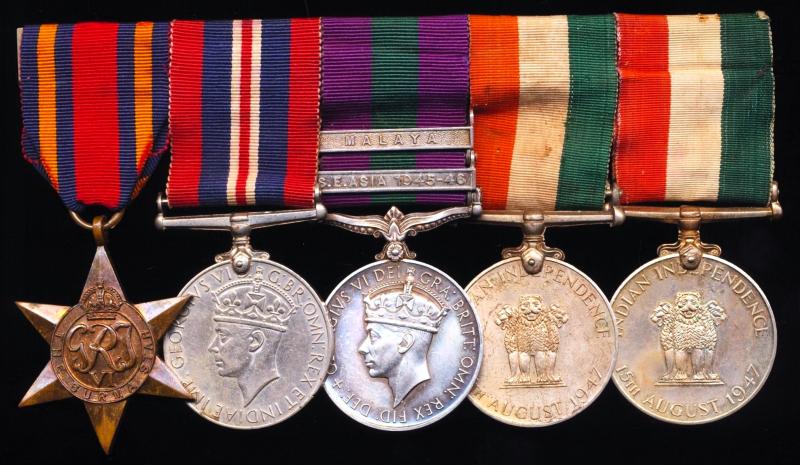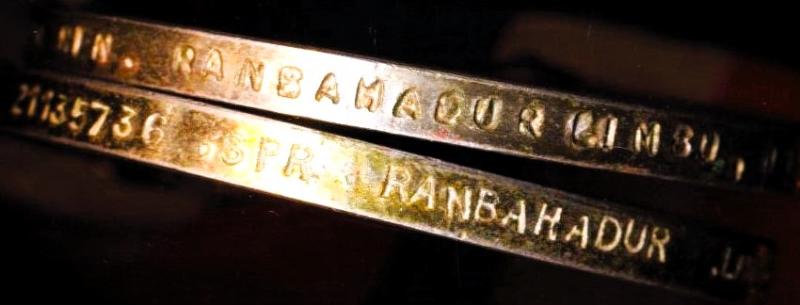A rare 'Double Issue' medal group of 5 to a former Gurkha Rifleman who fought against the Japanese in Burma and the Viet Minh in Indochina (Vietnam): Sapper Ranbahadur Limbu Gurkha Engineers late 11th Gurkha Rifles & 4th Battalion 10th Gurkha Rifles
- Burma Star
- War Medal 1939-45
- General Service Medal 1918-62. GVI clasps 'S.E. Asia 1945-46' & 'Malaya' (108655. Qfn. Ranb’dr Limbu. 4/10 G.R.)
- India Independence Medal 1947 (108655 Rfn. Ranbahadur Limbu. 11 G.R.)
- Indian Independence Medal 1947 (21135736. Spr. Ranbahadur. Limbu. G.R.)
GSM 1919-62: The upper claps attached by the customary rod. The first letter of the recipient abbreviated rank for Rifleman, has been officially impressed with the letter 'Q' rather then 'R' - the naming exactly as issued
portant: The only 'Infantry' units of the British Empire to serve in French Indochina (Vietnam) and fight against the Viet-Minh in the period 1945-46, were British & Indian Officers, together with Indian & Gurkha VCO's & 'Other Ranks' of the British Indian Army. All of the British Indian Army infantry units to serve in French Indochina had hitherto served in the Burma campaign fighting the Imperial Japanese Army
The recipient was a Nepalese soldier of Gurkha ethnicity from Easter Nepal, who at the time of the Malaya Emergency was holding the rank of Sapper, while serving with the Gurkha Engineers of the British Army
During the Second World War and immediate Post-War 1945-46 operations in Indochina (Vietnam), the recipient had served as an infantryman, holding the rank of Rifleman while serving with the war raised 4th Battalion 10th Gurkha Tifles of the British Indian Army
4th Battalion 10th Gurkha Rifles: Raised at Abbottabad, North West Frontier Province of British India, on, 15 March 1941. The battalion subsequently served in, India, Ceylon Colony, Burma & French Indochina (now Vietnam) and Cambodia. During its immediate post-war service in French Indochina 1945-46, it served as one of 3 x Indian Army infantry battalions under higher formations 100th Indian Infantry Brigade of 20th (Tulwar) Indian Division of the British Indian Army
By 17 October, the last units and formations of the 20th Indian Division had arrived and were ready to move against the Viet Minh. It was decided to send the 100th Indian Infantry Brigade, commanded by Brigadier C.H.B. 'Roddy' Rodham, and supporting arms to the north and north-east of Saigon into the Thu Duc/Thu Dau Mot/Bien Hoa areas. Intelligence reports stated that the Viet Minh strength lay in these areas, and there was a clear need to break the Viet Minh ring of control surrounding Saigon. Brigadier Rodham informed the Japanese command in the region that the 100th Brigade was coming to occupy the area and assume responsibility for the maintenance of law and order over the course of 23-25 October. The Japanese were asked to continue disarming the Viet Minh, searching for weapons, and clearing areas around the main towns. The Japanese troops now fell under the command of Brigadier Rodham and his brigade. The various units of the 100th Indian Brigade—the 1/1st Gurkha Rifles, 4/10th Gurkha Rifles, 14/13th Frontier Force Rifles 84 and the 16th Light Cavalry 85—carried out a well-planned and executed operation to clear the areas to the north of Saigon. The Japanese carried out the static duties of defence, while the Brigade operated mobile columns to destroy any opposition and deal with any road blocks. The units of the 100th Brigade defaulted to their wartime experience, and created combined arms mobile units. By the end of November, units of the 100th Indian Brigade had been used in mobile columns to engage pockets of the Viet Minh and had disarmed thousands of Japanese
While 10th Gurkha Rifles was one of the four Gurkha Rifles regiments that was selected to transfer to the British Army from 1 January 1948 - only the regular 1st & 2nd battalions of 10 GR were to be transferred - the two war raised, vis 3rd and 4th battalions being disbanded in India in 1946 & 1947 respectively. Gurkhas - including Rifleman Ranbahadur Limbu - from the disbanded 4/10 GR that wished to continue to serve with the Indian Army from 15 August 1947, were subsequently transferred to post Independence raised 11th Gurkha Rifles (vis the recipients 1st Independence Medal), all of whom received their Independence medals named to the post-independence 11th Gorkha Rifles, and not their pre-independence units. Evidently, Ranbahadur, subsequently quickly took his discharge from the Indian Army and enlisted in the British Army, being posted to the newly raised Gurkha Engineers (where cadres for the new unit were raised at Kluang, Malaya, in end 1948, then styled as Royal Engineers Gurkha, Gurkha Training Battalion), where for some reason, when the medal rolls were compiled Ranbahadur was awarded a second India Independence Medal. All Indian Independence Medals issued retroactively to Gurkha Engineers (which corps included Gurkha veterans of every former infantry regiment of the British Indian Army), were all officially impressed showing the generic unit designation 'G.R.' (for Gurkha Rifles). The only way of identifying, whether Independence Medals were named to any of the Gurkha Engineers, is the presence in the naming of the rank 'Sapper' abbreviated as Spr! Ranbahadur's Independence Medal being impressed with his 'Sapper' rank and his unique British Army number in the block uniquely allocated to the Brigade of Gurkhas from 1 January 1948
The medals mounted for wear 'In the Hills' the medals suspended from silk ribands. The reverse of the metal mounting bar retaining its original long hinged pin and clasp fittings
A most unusual and scarce double issue of the India Independence Medal
Condition: VF
Code: 24128






